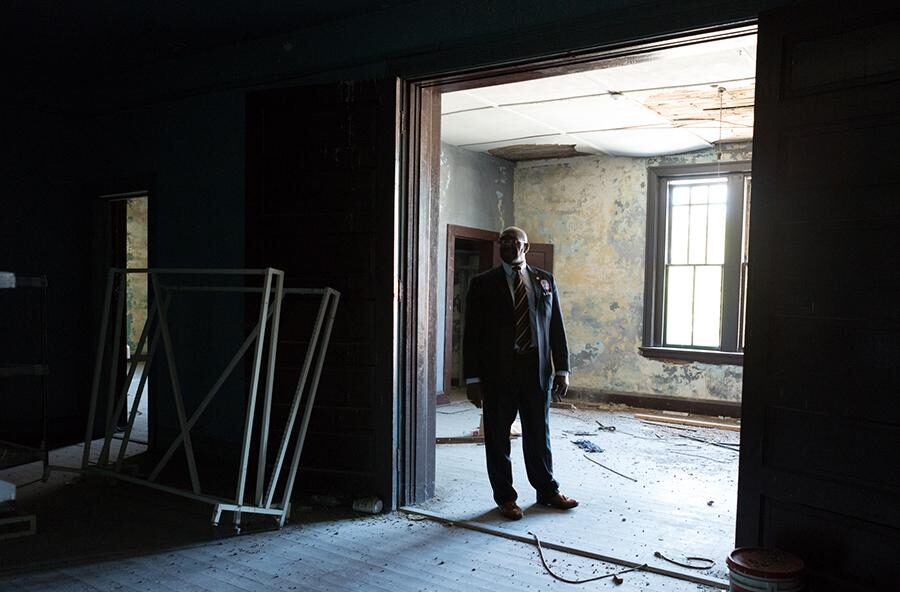A Pastor's Jericho in North Carolina
A Pastor's Jericho in North Carolina
Excerpt from A renovation project brings income to a church nonprofit and vitality to a former tobacco town by Bridgette A. Lacy for Faith & Leadership.
When the Rev. Dr. Michael Bell arrived at St. John AME Zion Church in 2004, he saw the blight surrounding his historic church and walked around the area seven times. The dilapidated houses needed something beyond local government help.
“I went straight to the Lord,” he said. Like Joshua in the Bible, Bell claimed the historically African American neighborhood of East Wilson. It was his Jericho.
The preacher from Jamaica started small, focusing on helping people in the neighborhood, first by hosting summer camps for children and later by converting the church parsonage into a shelter for homeless men.
Leveraging the capacity of the church’s nonprofit, the St. John Community Development Corporation, Bell worked to revitalize the area by buying deteriorating buildings, renovating them, and acting as landlord of the small businesses housed there.
“I believe in microenterprises,” Bell said. “Churches should not sit around and wait for tithings and offerings, because there are poor folks in your congregation who can’t give because they don’t have it to give. But through microenterprises, you can stimulate the economy and put people to work.”
Bell and the nonprofit are passionate about their mission to help at-risk youth and revitalize a section of Wilson left in despair by a changing economy.
East Wilson was once a predominately African American, working-class enclave. Black men working in the tobacco industry lived with their families in the small houses owned by their employers.
When the tobacco industry dried up and the local economy shifted to higher-skilled manufacturing jobs, the community lost its luster as landlords abandoned their properties or let them fall into disrepair. St. John AME Zion, a congregation founded in 1868 and located in a historic red-brick building, created the St. John CDC in 1998 to provide social and educational services as well as economic and workforce development.
But when Bell arrived as pastor in 2004, it was dormant. They had a 501(c)(3) and $60 in the bank. Nothing more. Through careful planning, fundraising, good negotiation, and some borrowed funds, the CDC has turned around, taking the community with it.
In 2005, St. John CDC established the Save A Youth program, which provides after-school care and summer camp for youth in grades K-8. It has served more than thirty-five hundred children.
Then it launched the downtown revitalization project, which was designed to provide funding for the youth programs as well as jobs and community development.
The nonprofit is also working on converting space into affordable apartment lofts and adding a laundromat and a small grocery store.
For Bell and the St. John CDC board, community development is just one aspect of the mission.
The real success lies in helping the community’s youth through its after-school programs, summer camp, gang prevention, vocational training, and other services.
At the end of the 2014-15 school year, nearly 97 percent of student participants tested in the after-school program performed at or above grade level. In June, the Save A Youth program held a graduation ceremony celebrating the academic successes of the 365 children in the program. St. John board member Ward said the graduation ceremony was a “real milestone,” and that seeing people from state officials to parents and grandparents at the event was a confirmation that their work is making a difference.
Bell said he’s not finished with his brand of urban renewal yet. “I want to go from block to block and remove the blight and create beauty and jobs.”
This story is part of Lake Institute’s story collection, the Faithful Generosity Story Shelf, which highlights congregations and other religious organizations who have sought to use their assets and resources in creative—and sometimes surprising—ways as an expression of faithful giving.
Each entry in our Story Shelf is short enough to be read and discussed during a committee meeting or other group gathering. Our hope is that these accessible vignettes will spark new questions, conversation, and imagination among clergy and laity about what might be possible with the funds, buildings, land, and other resources in their care. If you know a story that should be included in the Story Shelf, suggest it here.
Subscribe
Insights, a bi-weekly e-newsletter, is a resource for the religious community and fundraisers of faith-based organizations that provides:
- Reflections on important developments in the field of faith and giving
- Recommended books, studies and articles
- Upcoming Lake Institute events

